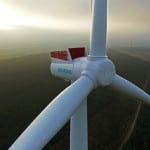By Kennedy Maize (@kennedymaize)
Washington, D.C., 15 Dec. 2012 – Pushed by the pending fiscal cliff and the expiration of 20 years of piecemeal tax subsidies, the U.S. wind industry is proposing a phase out of the production tax credit that has helped wind power to boom in the past few years. The proposal by the American Wind Energy Association, the industry’s Washington lobbyist, for a six-year phase out of wind tax credits has two targets.
AWEA’s proposal is aimed at critics who note that the production tax credit, created in 1992 comprehensive energy legislation, has always been billed as temporary but never seems to end. It also responds to wind project developers, who have complained about the periodic “perils of Pauline” drama over the wind tax credit expiration that regularly inserts uncertainty into investment decisions. It is also a first bet in a complex political poker game, and may represent the best the wind industry can get from a Congress and administration facing the fiscal cliff.
The AWEA plan would provide for 100% of the 2.2 cents/KWh 10-year production tax credit for projects the begin construction in 2013. The tax credit would fall to 90% for projects started in 2014, 80% for 2015 vintage projects, 70% for 2016, and 60% for 2017 and 2018, with the tax credit ending in 2018. In a letter to the leaders of the Senate Finance Committee and House Ways and Means Committee, AWEA CEO Denise Bode wrote that the phase-out plan would “sustain a minimally viable industry, able to continue achieving cost reductions.” She described the plan as provide a “stable extension” of the production tax credit.
At the same time, Bode said Congress should adopt “additional policy measures” to aid wind power, such as a national renewable energy standard to follow the lead of states that have adopted requirements that impose renewable energy quotas on utility power production and procurement.
The Obama administration has included extension of the wind production tax credit, which expires Dec. 31, in its negotiations with the Republican House of Representatives. But House Speaker John Boehner (R-Ohio) has rejected the plan. AWEA tried to garner support for the wind tax credit during the recent election campaign, arguing (and spending substantial money making the argument) that wind power is an job-creating engine. That effort failed, but a Democratic victory returned wind’s traditional allies to power.
In an interview last week, veteran renewable energy dealmaker Ed Feo told me he believes AWEA’s phase-out plan is “meaningful” and represents both political and economic realities, including “the limited value of short-term extensions” of the tax credit. He noted that the short-term nature of past renewals produced rushed projects designed to get in under the subsidy wire, which may have resulted in “diseconomies.”

In 2012, Feo observed, there was a land rush of 10 GW of wind installed, “heavily driven by the prospect of the tax benefit going away.” If the tax credit expires, wind development activity will grind to a halt, he said. “If we want a business that is sustainable,” Feo said, “we have got to have a policy that doesn’t create a cliff every couple of years. That’s what happened in 2012. AWEA tends to trumpet how much was installed this year. But that reflects the land rush kind of mentality, driving behavior in the short term and disregarding the long term.” Feo, a lawyer, is co-founder and managing director of USRG Renewable Finance.
Eventually the wind industry has to stand on its own, said Feo. “Today there are clearly places in the U.S. where wind works” without subsidies. “There are places where a buyer without a mandate might buy on his own, with the current cost of installation and today’s power prices.” While ending wind subsidies might mean a smaller industry than otherwise, he said, loss of the tax credit “doesn’t wipe the business out.”
What will be the timing of the wind tax credit issue? Feo told newsletter SNL Energy recently that he doubts the issue will be resolved during the current lame-duck session of the 112th Congress. But that doesn’t really matter, he said. “Activity for 2013 is on hold, so the difference between an extension in the fourth quarter of this year versus the first quarter next year doesn’t affect the industry levels that much.”
What’s most important, Feo said, is what the final product looks like. “The thing that is not going to be helpful is a relatively short-term extension, even on the current terms,” he said. “A 2013-only extension doesn’t move the needle a lot. Something with a multi-year extension is really where the value is.”
UPDATE: On Friday, AWEA CEO Denise Bode announced she will be leaving the wind energy lobbying group effective Jan. 1, to work as a Washington tax attorney-lobbyist. She has been at the wind group for four years. Bode told The Hill newspaper she will be involved in the coming battle over rewriting the federal tax code, representing energy and other firms. “I really want to get back in the fray and be an advocate,” she said. AWEA’s policy chief, Rob Gramlich, will serve as interim CEO until a the group’s board chooses a replacement for Bode.







